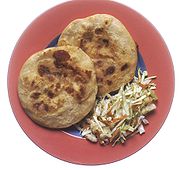Pupusa
From Wikipedia, the free encyclopedia
| This article needs additional citations for verification. Please help improve this article by adding reliable references (ideally, using inline citations). Unsourced material may be challenged and removed. (November 2007) |
A pupusa (from Pipil pupusawa) is a thick, hand-made corn tortilla (made using masa de maíz, a maize flour dough used in Latin American cuisine) that is stuffed with one or more of the following: cheese (queso) (usually a soft Salvadoran cheese called Quesillo), fried pork rind (chicharrón), squash (ayote), refried beans (frijoles refritos), or queso con loroco (loroco is a vine flower bud from Central America). There is also the pupusa revuelta with mixed ingredients, such as queso (cheese), frijoles (beans), [1], and chicharrón or bacon.
Contents |
[edit] History
Pupusas also known as Pupisio were first created by the Pipil tribes which dwelled in the territory which is now known as El Salvador. Cooking implements for their preparation have been found in Joya de Cerén, "El Salvador's Pompeii", site of a native village that was buried by ashes from a volcano explosion, and where foodstuffs were preserved as they were being cooked almost two thousand years ago. The instruments for their preparation have also been found in other archaeological sites in El Salvador.
In the late 1950s, pupusas were still not widespread across El Salvador, and were mostly localized in the central towns, such as Quezaltepeque, and cities of the country. As the population started to migrate to other areas, pupusas stands started to proliferate in the 1960s across the country and in the neighboring areas of Honduras and Guatemala, sometimes with variations in shape, size or filling. In Guatemala during the 1970s, pupusas had a half-moon shape. The half mooned shape would not be considered a pupusa it would be considered a half eaten pupusa in the Chalatenango area, it was not common to find fish pupusas, and their diameter was considerably bigger East of the Lempa river.
In the 1980s, a civil war forced a Salvadoran migration to other countries, mainly the United States. Therefore, pupusas became available outside the country wherever a Salvadoran community was found. In the United States, immigrants have brought the dish to Florida, New York, California, Nevada, North Carolina (especially Durham, North Carolina), Maryland, Virginia, Washington, D.C., Texas, East Boston, New Jersey, Nebraska, Lancaster, PA, St. Paul, Minnesota, Atlanta,Portland,OR and other locations, where there are now many pupuserías (a place where pupusas are sold and made). In Canada, pupuserías may be found in Toronto, (north york and city of york), Kensington Market, Southern Ontario, Eastern Ontario, Montréal, Québec, Winnipeg, Manitoba, Alberta and in Vancouver, BC.
Both at home and abroad, pupusas are now traditionally served with curtido (a "pickled" cabbage relish, that sometimes include hot peppers) and tomato sauce, and are traditionally eaten by hand.
There are many local folklore tales surrounding the dish. These tales often tell of diverse origins or effects of pupusas on people.
[edit] Variants and Cousins
A popular variant of the pupusa in El Salvador is the pupusa de arroz. Rice flour is used to make the masa, as the name indicates, and they are usually stuffed only with chicharron ( chopped pork) and cheese. They hail from the town of Olocuilta, located to the east of San Salvador, but are now readily available throughout the country.
Pupusas made in the United States are typically made with Maseca (brand name of a popular commercial corn flour-masa mix) instead of fresh masa harina. Some high-end pupuserías in the United States use rice flour and make low-carbohydrate versions with wheat flour.
A Mexican dish that is similar to the pupusa is called a gordita (literally, "chubby"), but gorditas are usually open at one end. In Venezuela they make arepas (where the dough is cooked first, and then sliced in half and stuffed somewhat like a hamburger). Colombia has its own recipe of arepas, but, unlike Venezuelan, Colombian arepas, are usually eaten without filling, or the filling is placed inside the dough before cooking. Pupusas are also found in neighboring Central American countries. Honduran pupusas often use the local quesillo type of cheese for the filling. In Costa Rica the pupusa variant consists on two fried tortillas with white cheese between them.
Taco Cabana, a Texas Tex-Mex chain, created a dish called the "Pupusa" that has no relation to the Salvadoran delicacy.[2]
[edit] Economy
In spite of its low market price, pupusas represent an important element in the economy of El Salvador. In addition to whole pupusas, the individual ingredients are also exported; for example, in 2005 $604,408 worth of loroco was sold to the United States alone.[citation needed]
[edit] Notes
| Wikibooks Cookbook has a recipe/module on |
- ^ Roxana Estrada. Pupusas, A Staple Food in El Salvador Topics Foods Around The World, May 25th, 2006
- ^ Eyder Peralta. Bona fide pupusas: Classic or clueless? Here's how to tell, Houston Chronicle Dining Guide, July 27, 2006, p. 4



